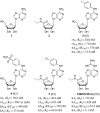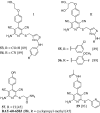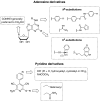Recent improvements in the development of A(2B) adenosine receptor agonists
- PMID: 18443746
- PMCID: PMC2583210
- DOI: 10.1007/s11302-008-9097-z
Recent improvements in the development of A(2B) adenosine receptor agonists
Abstract
Adenosine is known to exert most of its physiological functions by acting as local modulator at four receptor subtypes named A(1), A(2A), A(2B) and A(3) (ARs). Principally as a result of the difficulty in identifying potent and selective agonists, the A(2B) AR is the least extensively characterised of the adenosine receptors family. Despite these limitations, growing understanding of the physiological meaning of this target indicates promising therapeutic perspectives for specific ligands. As A(2B) AR signalling seems to be associated with pre/postconditioning cardioprotective and anti-inflammatory mechanisms, selective agonists may represent a new therapeutic group for patients suffering from coronary artery disease. Herein we present an overview of the recent advancements in identifying potent and selective A(2B) AR agonists reported in scientific and patent literature. These compounds can be classified into adenosine-like and nonadenosine ligands. Nucleoside-based agonists are the result of modifying adenosine by substitution at the N (6)-, C(2)-positions of the purine heterocycle and/or at the 5'-position of the ribose moiety or combinations of these substitutions. Compounds 1-deoxy-1-{6-[N'-(furan-2-carbonyl)-hydrazino]-9H-purin-9-yl}-N-ethyl-beta-D-ribofuranuronamide (19, hA(1) K (i) = 1050 nM, hA(2A) K (i) = 1550 nM, hA(2B) EC(50) = 82 nM, hA(3) K (i) > 5 muM) and its 2-chloro analogue 23 (hA(1) K (i) = 3500 nM, hA(2A) K (i) = 4950 nM, hA(2B) EC(50) = 210 nM, hA(3) K (i) > 5 muM) were confirmed to be potent and selective full agonists in a cyclic adenosine monophosphate (cAMP) functional assay in Chinese hamster ovary (CHO) cells expressing hA(2B) AR. Nonribose ligands are represented by conveniently substituted dicarbonitrilepyridines, among which 2-[6-amino-3,5-dicyano-4-[4-(cyclopropylmethoxy)phenyl]pyridin-2-ylsulfanyl]acetamide (BAY-60-6583, hA(1), hA(2A), hA(3) EC(50) > 10 muM; hA(2B) EC(50) = 3 nM) is currently under preclinical-phase investigation for treating coronary artery disorders and atherosclerosis.
Figures




Similar articles
-
Recent improvements in the development of A(2B) adenosine receptor agonists.Purinergic Signal. 2009 Mar;5(1):3-19. doi: 10.1007/s11302-009-9140-8. Epub 2009 Jan 31. Purinergic Signal. 2009. PMID: 19184536 Free PMC article.
-
Design, synthesis, and biological evaluation of new 8-heterocyclic xanthine derivatives as highly potent and selective human A2B adenosine receptor antagonists.J Med Chem. 2004 Mar 11;47(6):1434-47. doi: 10.1021/jm0309654. J Med Chem. 2004. PMID: 14998332
-
Recent developments in A2B adenosine receptor ligands.Handb Exp Pharmacol. 2009;(193):99-122. doi: 10.1007/978-3-540-89615-9_4. Handb Exp Pharmacol. 2009. PMID: 19639280 Review.
-
New 2-heterocyclyl-imidazo[2,1-i]purin-5-one derivatives as potent and selective human A3 adenosine receptor antagonists.J Med Chem. 2011 Jul 28;54(14):5205-20. doi: 10.1021/jm2004738. Epub 2011 Jun 28. J Med Chem. 2011. PMID: 21675777
-
The role of the adenosinergic system in lung fibrosis.Pharmacol Res. 2013 Oct;76:182-9. doi: 10.1016/j.phrs.2013.08.004. Epub 2013 Aug 28. Pharmacol Res. 2013. PMID: 23994158 Review.
Cited by
-
Epithelial-specific A2B adenosine receptor signaling protects the colonic epithelial barrier during acute colitis.Mucosal Immunol. 2015 Nov;8(6):1324-38. doi: 10.1038/mi.2015.22. Epub 2015 Apr 8. Mucosal Immunol. 2015. PMID: 25850656 Free PMC article.
-
Blood Platelet Adenosine Receptors as Potential Targets for Anti-Platelet Therapy.Int J Mol Sci. 2019 Nov 3;20(21):5475. doi: 10.3390/ijms20215475. Int J Mol Sci. 2019. PMID: 31684173 Free PMC article. Review.
-
Adenosine activation of A(2B) receptor(s) is essential for stimulated epithelial ciliary motility and clearance.Am J Physiol Lung Cell Mol Physiol. 2011 Aug;301(2):L171-80. doi: 10.1152/ajplung.00203.2010. Epub 2011 May 27. Am J Physiol Lung Cell Mol Physiol. 2011. PMID: 21622845 Free PMC article.
-
Aldehyde dehydrogenase type 2 activation by adenosine and histamine inhibits ischemic norepinephrine release in cardiac sympathetic neurons: mediation by protein kinase Cε.J Pharmacol Exp Ther. 2012 Oct;343(1):97-105. doi: 10.1124/jpet.112.196626. Epub 2012 Jul 3. J Pharmacol Exp Ther. 2012. PMID: 22761303 Free PMC article.
-
Introduction to adenosine receptors as therapeutic targets.Handb Exp Pharmacol. 2009;(193):1-24. doi: 10.1007/978-3-540-89615-9_1. Handb Exp Pharmacol. 2009. PMID: 19639277 Free PMC article. Review.
References
-
- {'text': '', 'ref_index': 1, 'ids': [{'type': 'DOI', 'value': '10.1016/0165-6147(88)90194-0', 'is_inner': False, 'url': 'https://doi.org/10.1016/0165-6147(88)90194-0'}, {'type': 'PubMed', 'value': '2907698', 'is_inner': True, 'url': 'https://pubmed.ncbi.nlm.nih.gov/2907698/'}]}
- Fredholm BB, Dunwiddie TV (1988) How does adenosine inhibit transmitter release? Trends Pharmacol Sci 9:130–134 - PubMed
-
- {'text': '', 'ref_index': 1, 'ids': [{'type': 'DOI', 'value': '10.1038/414916a', 'is_inner': False, 'url': 'https://doi.org/10.1038/414916a'}, {'type': 'PubMed', 'value': '11780065', 'is_inner': True, 'url': 'https://pubmed.ncbi.nlm.nih.gov/11780065/'}]}
- Ohta A, Sitkovsky M (2001) Role of G-protein-coupled adenosine receptors in downregulation of inflammation and protection from tissue damage. Nature 414:916–920 - PubMed
-
- {'text': '', 'ref_index': 1, 'ids': [{'type': 'DOI', 'value': '10.1111/j.1527-3466.2006.00116.x', 'is_inner': False, 'url': 'https://doi.org/10.1111/j.1527-3466.2006.00116.x'}, {'type': 'PubMed', 'value': '16961725', 'is_inner': True, 'url': 'https://pubmed.ncbi.nlm.nih.gov/16961725/'}]}
- Forman MB, Stone GW, Jackson EK (2006) Role of adenosine as adjunctive therapy in acute myocardial infarction. Cardiovasc Drug Rev 24:116–147 - PubMed
-
- {'text': '', 'ref_index': 1, 'ids': [{'type': 'DOI', 'value': '10.1016/j.physbeh.2007.05.031', 'is_inner': False, 'url': 'https://doi.org/10.1016/j.physbeh.2007.05.031'}, {'type': 'PubMed', 'value': '17574632', 'is_inner': True, 'url': 'https://pubmed.ncbi.nlm.nih.gov/17574632/'}]}
- Dare E, Schulte G, Karovic O et al (2007) Modulation of glial cell functions by adenosine receptors. Physiol Behav 92:15–20 - PubMed
-
- {'text': '', 'ref_index': 1, 'ids': [{'type': 'DOI', 'value': '10.1152/physrev.00043.2006', 'is_inner': False, 'url': 'https://doi.org/10.1152/physrev.00043.2006'}, {'type': 'PubMed', 'value': '17429044', 'is_inner': True, 'url': 'https://pubmed.ncbi.nlm.nih.gov/17429044/'}]}
- Burnstock G (2007) Physiology and pathophysiology of purinergic neurotransmission. Physiol Rev 87:659–797 - PubMed
LinkOut - more resources
Full Text Sources
Other Literature Sources
Research Materials

